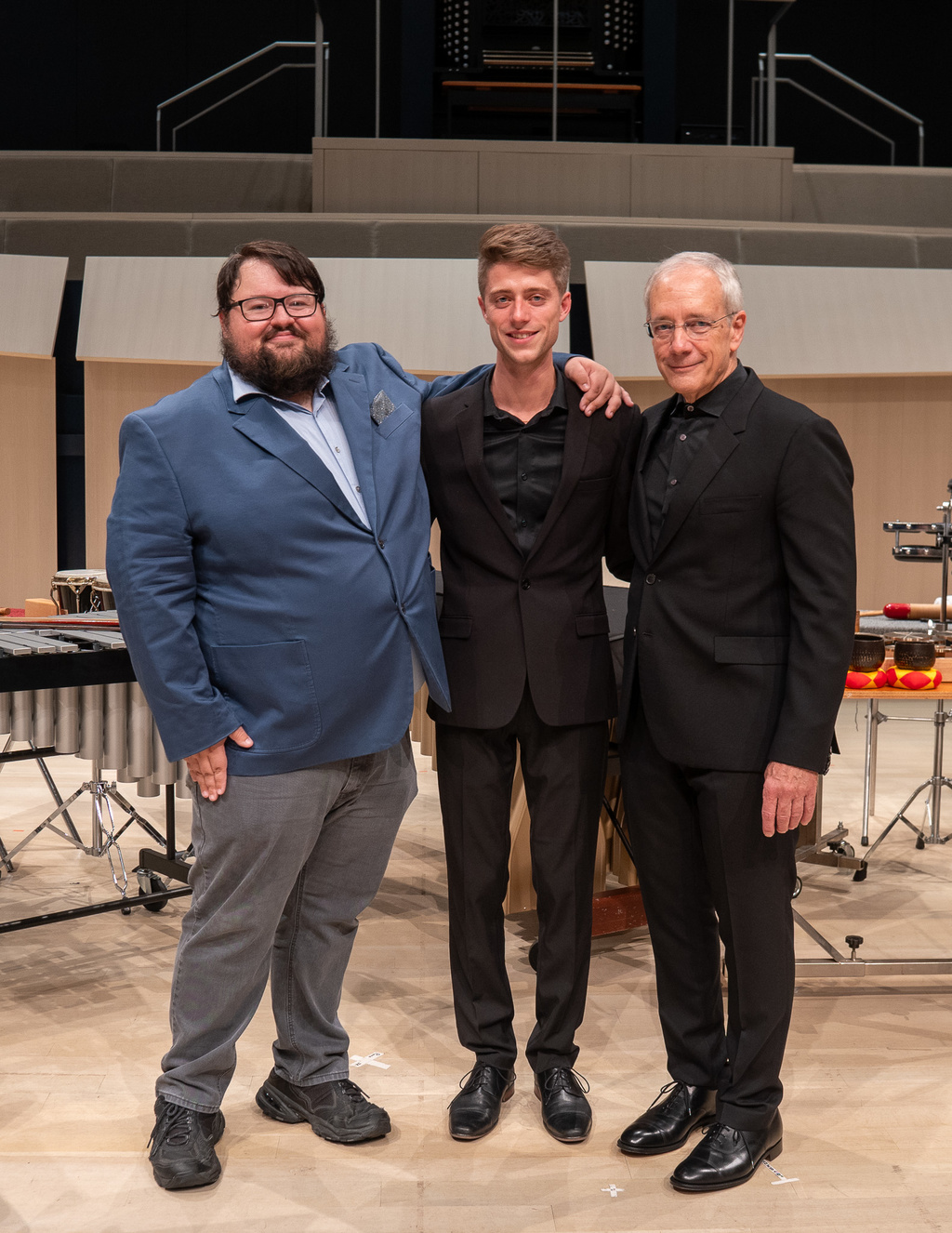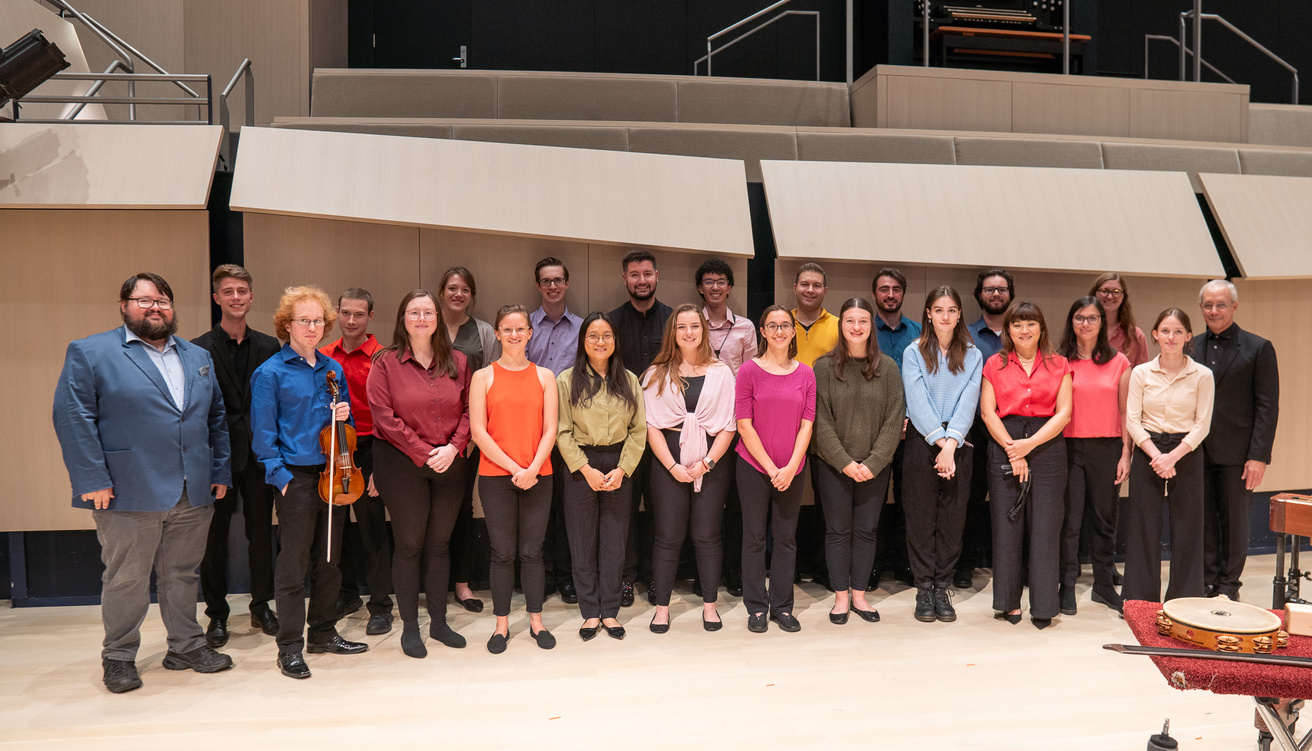CNM Ensemble Concert I
Sunday, September 24, 2023 at 7:30p in the Concert Hall
Program
Entropic Arrows, for ensemble (2019) | Anna THORVALDSDOTTIR |
| Josh Stine, flute Sayyod Mirzomurodov, clarinet Kimmy Moore, percussion Yestyn Griffith, violin 1 Michael Klyce, violin 2 Rebecca Vieker, viola Hanna Rumora, violoncello David Gompper, conductor |
Terpsichore’s Box of Dreams, for 13 virtuosi (2023) | Augusta Read THOMAS |
| Josh Stine, flute David Cyzak, oboe Sayyod Mirzomurodov, clarinet Christopher Hunley, saxophone Kristen Ronning, horn McKenna Blenk and Nathan Ortiz, percussion Erin Freund, harp Neil Krzeski, piano Yestyn Griffith, violin 1 Michael Klyce, violin 2 Rebecca Vieker, viola Hanna Rumora, violoncello David Gompper, conductor |
intermission
|
| Craig Jordan, piano solo Josh Stine, flute David Cyzak, oboe Sayyod Mirzomurodov, clarinet Lea Banks, bass clarinet Christopher Hunley, saxophone JoAnne Sukumaran, bassoon Kristen Ronning, horn Anna Kelly, trumpet Xiaoyu Liu, trombone Hannah Oberhoffer and Charli Otto, percussion Yestyn Griffith, violin 1 Michael Klyce, violin 2 Rebecca Vieker, viola Hanna Rumora, violoncello Natalia Terra, double bass David Gompper, conductor |
Program Notes and biographies
| Entropic Arrows - Cast in a single movement, this chamber work is characterized by the fusion of sound textures with discrete forms of lyrical material. The title is taken from the concept of “entropy” in physics: in essence, the amount of disorder that is found in the system. Applied to music, entropy can be defined as the temporal evolution of a musical structure. The word “arrows” implies the way energy increases or decreases over time. Finally, the concept of a rhizomatic process should be considered here, a way of structuring music that lacks a clear defining shape, and is in many ways directionless, horizontal (not hierarchical). Think of a ginger plant, which is a rhizome root. The music communicates a feeling of boundless sonic landscape with nothing to impede its shape or flow. Masses of sounds move, slide into each other, and vanish. Individual instruments tend to be blurred that results in the ensemble to move as a single body. You will hear a two-note motive that is passed around, first in the strings and finally in the winds. The percussion serves first as background, slowly becoming part of the rhythmic articulation that is first introduced in the strings. (David Gompper) |
| Anna Thorvaldsdottir (b. 1977) is an Icelandic composer whose "seemingly boundless textural imagination” (NY Times) and "striking” (Guardian) sound world has made her "one of the most distinctive voices in contemporary music” (NPR). "Never less than fascinating” (Gramophone), her music is composed as much by sounds and nuances as by harmonies and lyrical material, and tends to evoke "a sense of place and personality” (NY Times) through a distinctive "combination of power and intimacy” (Gramophone). It is written as an ecosystem of sounds, where materials continuously grow in and out of each other, often inspired in an important way by nature and its many qualities, in particular structural ones, like proportion and flow. Anna’s works have been nominated and awarded on many occasions - most notably, her "confident and distinctive handling of the orchestra” (Gramophone) has garnered her the prestigious Nordic Council Music Prize, the New York Philharmonic's Kravis Emerging Composer Award, and Lincoln Center’s Emerging Artist Award and Martin E. Segal Award. |
| Terpsichore's Box of Dreams (2023) In ancient Greek mythology, the muse Terpsichore, a daughter of Zeus and Mnemosyne, is the goddess of dance and delight. With her in mind, I have sought to sculpt music that allows our individual and collective creative work to turn freely in the air. Terpsichore’s Box of Dreams is by turns lively, sprightly, spry, energetic, vigorous; it is animated, traveling, flexible, versatile, changing, fluid, and buoyant. While this is not exactly a “concerto for ensemble,” each of the thirteen musicians is featured in several soloistic, virtuosic passages. What will pop out of Terpsichore’s box next? This composition, which starts with Terpsichore’s entrance and ends with her departure, imagines the magic box that contains many things, including seven varied, colorful, dimensional dances: 1, Scatter; 2, Tiptoe Caper; 3, Pointillistic Groove Flutter Pirouettes; 4, Slalom; 5, Dream; 6, Gambol; 7, Romp. The form is a crescendo of instrumental expertise: throughout the seventeen-minute composition the brief dances become progressively more virtuosic. The longest dance is no. 5, Dream, which begins at the midpoint of the composition. Elegant, lyrical, and resonant, it concludes with an awakening-from-the-slumber-of-dream at sunrise, with morning birds and running squirrels. Suddenly the sixth dance, Gambol, swirls forward. After a fifty-second interlude featuring solo violin, oboe, and clarinet, it leads to the irreversible escapade that is dance no. 7, Romp. Terpsichore’s Box of Dreams unfolds a labyrinth of musical interrelationships and connections that showcase the thirteen world-class musicians of the Grossman Ensemble. Here is a virtuosic display of rhythmic and timbral dexterity, counterpoint, skill, energy, dynamic and articulative range, precision, and teamwork. When feasible the composition is to be performed with dancers. |
| The music of Augusta Read Thomas (b. 1964 in New York) is nuanced, majestic, elegant, capricious, lyrical, and colorful — "it is boldly considered music that celebrates the sound of the instruments and reaffirms the vitality of orchestral music" (Philadelphia Inquirer). A composer featured on a Grammy winning CD by Chanticleer and Pulitzer Prize finalist, Thomas’ impressive body of works “embodies unbridled passion and fierce poetry” (American Academy of Arts and Letters). The New Yorker magazine called her "a true virtuoso composer." Championed by such luminaries as Barenboim, Rostropovich, Boulez, Eschenbach, Salonen, Maazel, Ozawa, and Knussen, she rose early to the top of her profession. The American Academy of Arts and Letters described Thomas as “one of the most recognizable and widely loved figures in American Music." She is a University Professor of Composition in Music and the College at The University of Chicago. Thomas was the longest-serving Mead Composer-in-Residence with the Chicago Symphony Orchestra for conductors Daniel Barenboim and Pierre Boulez (1997-2006). Thomas won the Ernst von Siemens Music Prize, among many other coveted awards. She is a member of the American Academy of Arts and Sciences, and a member of the American Academy of Arts and Letters. Thomas was named the 2016 Chicagoan of the Year. Recent and upcoming commissions include those from the Santa Fe Opera in collaboration with the San Francisco Opera and other opera companies, PEAK Performances at Montclair State University and the Martha Graham Dance Company, The Cathedral Choral Society of Washington D.C., The Indianapolis Symphony, Tanglewood, The Kaleidoscope Chamber Orchestra, Des Moines Symphony, Boston Symphony, the Utah Symphony, Wigmore Hall in London, JACK quartet, Third Coast Percussion, Spektral Quartet, Chicago Philharmonic, Eugene Symphony, the Danish Chamber Players, Notre Dame University, Janet Sung, Lorelei Vocal Ensemble, and the Fromm Foundation. |
| Craig Jordan, from Ames, Iowa, is pursuing his Doctor of Music degree in Piano Performance and Pedagogy at the University of Iowa in the studio of Dr. Réne Lecuona. In September 2023, Craig traveled to Natal, Brazil to participate in the “V Festival do Piano de Natal - Conexões Pianísticas” where he and other pianists from the University of Iowa collaborated with students in Natal to perform Rzewski’s “The People United Will Never Be Defeated!” He completed his Master of Music degree at the University of Miami studying with Professor Tian Ying where he most notably performed the Seaborne Concerto for percussion sextet, orchestra, and film as a winner of the 2021 concerto competition. During this time, he had the privilege of performing with the Frost Symphony Orchestra (piano, celeste, and harpsichord) under the direction of Conductor Gerard Schwarz. “... ably played by Craig Jordan, seemed to emerge from some distant world” (South Florida Classical Review, Oct 2021). Craig received his Bachelor of Music from the Lawrence Conservatory of Music in the studio of Dr. Catherine Kautsky where he was awarded Lawrence University’s Marjory Irvin Prize for Excellence in Piano Performance. |
| Things That Drift Ashore draws creative inspiration from the works of Junji Ito and focuses on concepts of physical and sonic disfiguration. The piano serves as an intermediary device, intended to provide visual translations of sonic material. The use of a second piano in the percussion section features as both a compliment (in its ability to sustain pitch through varied prepared technique) and as a foil (in the “disfiguration” of the piano’s melodic and harmonic material through the same preparatory means). In Junji Ito’s work, the metamorphosis undergone by characters is often not acknowledged in the world of the characters but rather serves as a visual indication of varying concepts of benevolence or malice to audience members. I was interested in establishing this discord through the use of the pianist as a soloist for the work as I often grapple with my background as a pianist in both a solo and accompaniment setting. I considered, while writing this piece, three views of myself: how I viewed myself, how I felt I was viewed, and how I was told I was viewed. Thoughts of these views would consistently visit me throughout the composition, adding more to the list of things that would drift ashore. I would like to extend my dearest gratitude to Craig for taking on the solo for this piece. I couldn’t ask for a better premiering artist. Without him, and the wonderful musicians of the Center for New Music, this piece wouldn’t have been possible. |
| Matt A. Mason is a composer, pianist, and educator from Lincoln Illinois whose work has been described as "brooding, tense," "heartbreaking," and brimming with "constellations of pitch and rhythm in a densely complex mesh." Matt's work as a composer draws deeply from his rural midwestern background, telling stories about queer visibility, nostalgia, social responsibility, and trauma. Matt is currently a Visiting Assistant Professor of Musicianship at Roosevelt University in Chicago, and holds a Bachelor's in Piano Performance and Pedagogy (Illinois Wesleyan), a Master's degree in Composition and Piano Performance (Butler University), and a PhD in Music Composition and Theory (University of Iowa). Matt has presented his research on gender performance in popular music at the Universities of Chicago, Kentucky, Iowa, and Oregon. Matt has worked with prestigious ensembles such as the JACK Quartet, Ensemble Dal Niente, Impulse Ensemble, Random Access Music, Hypercube, The Center for New Music, Out of the Box, and has participated in celebrated international projects such as 250 Piano Pieces for Beethoven, Songs from the Levant, Dances for Water, and Moments in this Time. |

